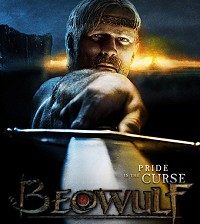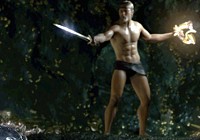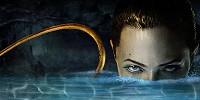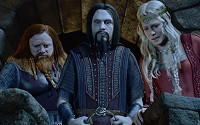 Pure Beowulf
Pure Beowulf A week before the film's global release, Warner Bros held a typically lavish junket to launch the film for hundreds of journalists from all over the world. Many of us had been there a few months earlier when the producers unveiled one finished reel of footage for us, but now we were going to see the whole film in 3D on the Imax screen.
A week before the film's global release, Warner Bros held a typically lavish junket to launch the film for hundreds of journalists from all over the world. Many of us had been there a few months earlier when the producers unveiled one finished reel of footage for us, but now we were going to see the whole film in 3D on the Imax screen.And it's not just any old film. This is a collaboration of notable writers Neil Gaiman and Roger Avary with director Robert Zemeckis to bring the "unfilmable" Old English poem Beowulf to the big screen. Gaiman and Avary spent more than a decade working on this, picking the story apart until they filled in all the gaps and created a lucid through-line of a plot. And Zemeckis brought his considerable envelope-pushing skills to bear on the project, taking the motion-capture techniques he pioneered with Polar Express (2004) far beyond what anyone has ever done on screen.
What emerges is a muscly epic that's definitely not for kids, with extreme grisliness and plenty of near-nudity in a gripping story of personal choices with massive ramifications. The directorial style is sweeping and extremely eye-catching, and will appeal to the same crowd that turned 300 into a mega-hit. Although this story is much better.
Even so, the technology is still criticised for the dead-eye effect, which makes it look as if waxwork versions of recognisable actors are performing the roles. Still, their movements are amazingly lifelike. And the detail is astounding. Especially in Imax 3D.
After the screening, we had a chance to talk with a cross-section of actors, writers and producers about the production process.
Pure imagination
"Motion capture was the only way Robert Zemeckis thought he could realise his dream to tell this story, create the characters and bring in the greatest actors to bring them to life," says producer Steve Starkey.
And the results impressed even the filmmakers. "I've been working on this story for 10 years," says writer Roger Avary, "so I thought I'd be jaded by now. But seeing it in Imax 3D was so much more than we could have imagined. It's actually pure imagination."
"It's far beyond what we technically could have imagined when we started," says writer Neil Gaiman, "Actually, back then we couldn't have imagined Angelina Jolie in the role - she was still in school!"
And just because it's an animated film doesn't mean the actors just stood in a studio with a microphone. Zemeckis' technique involves the actors performing the entire film on a stage.
"It was just like being in a rehearsal room for a theatre," says Anthony Hopkins. "And when they shoot it you're not really aware of the cameras."
Pure cinema
"Although in this case the camera doesn't miss a thing. Every look or moment is up there - it's pure cinema," adds Ray Winstone, the actor who is most physically transformed by the animators into the towering Norseman of the title.
Although Crispin Glover is quick to note that "what you see on the screen is all actors all the time, 100 percent all the way."
"You have a freedom to do what you want," says Hopkins. "You have a general idea of the set design and the weight of the costumes. Then it's pretty straightforward, and you just jump in at the deep end. I asked Bob how drunk he wanted me to be in the opening scene, and we just went with it. The only big surprise is seeing it on screen two years later."
Pure performance
"Seeing it two years after filming feels like time travel," says Winstone. "It's a strange feeling, kind of sad maybe because it didn't look like me up there. But then you see him move, and it's definitely my performance. In fact, it's kind of the purest performance there can be, because I played the role before they added the makeup and costumes."
And it got him thinking: "Using this technology I could play Marilyn Monroe!" he says, laughing. "This opens up the opportunity for an actor to play anything. But this was still the most physically demanding part I've ever played. Although it's not hard to feel sexy when you're working opposite Angelina Jolie and Robin Wright Penn. And of course I enjoyed being 6 foot 6 with an 8-pack. It's great to be 20 again!"
The other actor most transformed on screen is Glover, as the fierce creature Grendel, who spurs the events of the plot. But Glover is quick to point out that he's not just the villain of the piece. "It was clear in the screenplay what his intentions were. And it wasn't the word 'monster'," he says. "It was this problem he has with his ear. All the noise drives him crazy, and he needed to sort that out. And something Bob said to me helped a lot: for him, every movement causes pain."
Gaiman adds that audiences will be able to sympathise with Grendel, "listening to this party raging - you know what it's like to want to go in and rip a few people in half and bite a few heads off!"
And Grendel also has the most unusual voice in the film, speaking in an ancient dialect. "I studied Old English to learn how it worked and to sound it out phonetically. Then Bob Zemeckis wanted me to improvise in it, to just talk. I enjoyed all of that," Glover says. "Sure, a lot of the aggressive sounds had more to do with the pain. And by the end of the day, I needed a lot of hot tea and to just go home and rest so the screaming didn't stay with me."
For Glover, one of the attractions of the project was the chance to reunite with Zemeckis more than 20 years after Back to the Future.
For Winstone, it was the fact that it's an English story. "The film doesn't feel like a Hollywood blockbuster," he notes. "It feels more European."
And Hopkins says, "Working with Bob Zemeckis was enticing to me - he's a genius. He explained the process to me, and I was intrigued. The ingenuity of it was astonishing."
Pure collaboration
"Bob has a singular directorial vision - everything in the film is the way he saw it in his mind's eye," says Starkey. "But everything that's up there on screen has been created, and there are literally hundreds of artists behind it."
Avary adds, "We had about 6,000 people working on this and more computer power than the NSA! It's a big machine, but it was also the most collaborative project I've ever worked on."
"We all dealt with Bob Zemeckis," says Gaiman, "but what he wanted was to have good people working around him."
"Every film Bob makes demands some new technique," says Starkey. "This is a whole new form of cinema."
BFI IMAX, LONDON, 9 NOV 07








